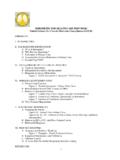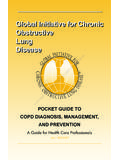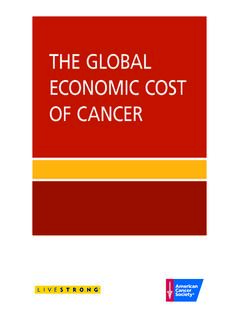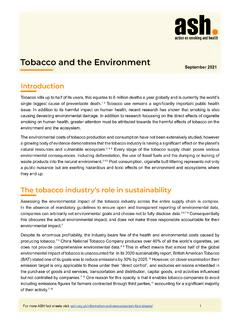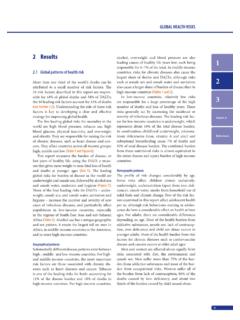Transcription of Global Initiative for Chronic Disease DISTRIBUTE OR COPY ...
1 Global Initiative for ChronicObstructiveLungDiseaseGlobal Initiative for ChronicObstructiveLungDiseasePOCKET GUIDE TOCOPD DIAGNOSIS, MANAGEMENT, AND PREVENTIONA Guide for Health Care Professionals 2018 REPORT COPYRIGHTED MATERIAL- DO NOT COPY OR DISTRIBUTE ii Global Initiative FOR Chronic OBSTRUCTIVE LUNG Disease POCKET GUIDE TO COPD DIAGNOSIS, MANAGEMENT, AND PREVENTION A Guide for Health Care Professionals 2018 EDITION 2018 Global Initiative for Chronic Obstructive Lung Disease , Inc. COPYRIGHTED MATERIAL- DO NOT COPY OR DISTRIBUTE GOLD BOARD OF DIRECTORS (2017) GOLD SCIENCE COMMITTEE* (2017) Alvar Agusti, MD, Chair Respiratory Institute, Hospital Clinic, IDIBAPS Univ. Barcelona and Ciberes Barcelona, Spain Bartolome R. Celli, MD Brigham and Women s Hospital Boston, Massachusetts, USA Rongchang Chen, MD Guangzhou Institute of Respiratory Disease Guangzhou, PRC Gerard Criner, MD Temple University School of Medicine Philadelphia, Pennsylvania, USA Peter Frith, MD Repatriation General Hospital, Adelaide, South Australia, Australia David Halpin, MD Royal Devon and Exeter Hospital Devon, UK M.
2 Victorina L pez Varela, MD Universidad de la Rep blica Montevideo, Uruguay Masaharu Nishimura, MD Hokkaido University School of Medicine Sapporo, Japan Claus Vogelmeier, MD University of Marburg Marburg, Germany Claus Vogelmeier, MD, Chair University of Marburg Marburg, Germany Alvar Agusti, MD Respiratory Institute, Hospital Clinic, IDIBAPS Univ. Barcelona and Ciberes Barcelona, Spain Antonio Anzueto, MD University of Texas Health Science Center San Antonio, Texas, USA Peter Barnes, MD National Heart and Lung Institute London, United Kingdom Jean Bourbeau, MD McGill University Health Centre Montreal, Canada Gerard Criner, MD Temple University School of Medicine Philadelphia, Pennsylvania, USA Peter Frith, MD Repatriation General Hospital, Adelaide, South Australia,Australia David Halpin, MD Royal Devon and Exeter Hospital, Devon, United Kingdom Fernando J.
3 Martinez, MD, MS New York-Presbyterian Hospital/ Weill Cornell Medical Center New York, NY USA Nicolas Roche, MD H pital Cochin Paris, France Donald Sin, MD St. Paul s Hospital, University of British Columbia Vancouver, Canada Dave Singh, MD University of Manchester Manchester, UK Robert Stockley, MD University Hospital Birmingham, UK J rgen Vestbo, MD University of Manchester Manchester, England, UK Jadwiga A. Wedzicha, MD Imperial College London London, UK M. Victorina L pez Varela,MDUniversidad de la Rep blica Hospital Maciel Montevideo, Uruguay GOLD PROGRAM DIRECTOR Rebecca Decker, MSJ Fontana, Wisconsin, USA *Disclosure forms for GOLD Committees are posted on the GOLD Website, COPYRIGHTED MATERIAL- DO NOT COPY OR DISTRIBUTE iv TABLE OF CONTENTS TABLE OF CONTENTS .. IV Global STRATEGY FOR THE DIAGNOSIS, MANAGEMENT, AND PREVENTION OF COPD.
4 1 INTRODUCTION .. 1 DEFINITION AND OVERVIEW .. 1 OVERALL KEY POINTS: .. 1 WHAT IS Chronic OBSTRUCTIVE PULMONARY Disease (COPD)? .. 2 WHAT CAUSES COPD? .. 2 DIAGNOSIS AND ASSESSMENT OF COPD .. 4 OVERALL KEY POINTS: .. 4 DIAGNOSIS .. 4 DIFFERENTIAL DIAGNOSIS .. 5 ASSESSMENT .. 6 Classification of severity of airflow obstruction .. 6 Assessment of symptoms .. 6 Combined COPD assessment .. 8 EVIDENCE SUPPORTING PREVENTION AND MAINTENANCE THERAPY .. 9 OVERALL KEY POINTS: ..9 SMOKING CESSATION .. 10 VACCINATIONS .. 10 Influenza vaccine .. 10 Pneumococcal vaccine .. 10 PHARMACOLOGIC THERAPY FOR STABLE COPD .. 11 Bronchodilators .. 11 Beta2-agonists .. 11 Antimuscarinic drugs .. 12 12 Combination bronchodilator therapy .. 12 Anti-inflammatory agents .. 14 Inhaled corticosteroids (ICS) .. 14 Issues related to inhaled delivery .. 16 Other pharmacologic treatments .. 17 REHABILITATION, EDUCATION & SELF-MANAGEMENT.
5 18 Pulmonary rehabilitation .. 18 SUPPORTIVE, PALLIATIVE, END-OF-LIFE & HOSPICE CARE .. 18 Symptom control and palliative care .. 18 OTHER TREATMENTS .. 19 Oxygen therapy and ventilatory support .. 19 MANAGEMENT OF STABLE COPD .. 21 OVERALL KEY POINTS: .. 21 IDENTIFY AND REDUCE EXPOSURE TO RISK FACTORS .. 22 TREATMENT OF STABLE COPD .. 23 PHARMACOLOGIC TREATMENT .. 23 Pharmacologic treatment algorithms .. 24 MONITORING AND FOLLOW-UP .. 28 MANAGEMENT OF EXACERBATIONS .. 28 OVERALL KEY POINTS: .. 28 TREATMENT OPTIONS .. 29 Treatment Setting .. 29 HOSPITAL DISCHARGE AND FOLLOW-UP .. 33 COPD AND COMORBIDITIES .. 34 OVERALL KEY POINTS: .. 34 REFERENCES .. 35 COPYRIGHTED MATERIAL- DO NOT COPY OR DISTRIBUTE 1 Global STRATEGY FOR THE DIAGNOSIS, MANAGEMENT, AND PREVENTION OF COPDINTRODUCTION Chronic Obstructive Pulmonary Disease (COPD) represents an important public health challenge and is a major cause of Chronic morbidity and mortality throughout the world.
6 COPD is currently the fourth leading cause of death in the world1 but is projected to be the 3rd leading cause of death by 2020. More than 3 million people died of COPD in 2012 accounting for 6% of all deaths globally. Globally, the COPD burden is projected to increase in coming decades because of continued exposure to COPD risk factors and aging of the This Pocket Guide has been developed from the Global Strategy for the Diagnosis, Management, and Prevention of COPD (2018 Report), which aims to provide a non-biased review of the current evidence for the assessment, diagnosis and treatment of patients with COPD that can aid the clinician. Discussions of COPD and COPD management, evidence levels, and specific citations from the scientific literature are included in that source document, which is available from The tables and figures in this Pocket Guide follow the numbering of the 2018 Global Strategy Report for reference consistency.
7 DEFINITION AND OVERVIEW OVERALL KEY POINTS: Chronic Obstructive Pulmonary Disease (COPD) is a common, preventable and treatable Disease that is characterized by persistent respiratory symptoms and airflow limitation that is due to airway and/or alveolar abnormalities usually caused by significant exposure to noxious particles or gases. The most common respiratory symptoms include dyspnea, cough and/or sputum production. These symptoms may be under-reported by patients. The main risk factor for COPD is tobacco smoking but other environmental exposures such as biomass fuel exposure and air pollution may contribute. Besides exposures, host factors predispose individuals to develop COPD. These include genetic abnormalities, abnormal lung development and accelerated aging. COPD may be punctuated by periods of acute worsening of respiratory symptoms, called exacerbations.
8 In most patients, COPD is associated with significant concomitant Chronic diseases, which increase its morbidity and mortality. 1 COPYRIGHTED MATERIAL- DO NOT COPY OR DISTRIBUTE 2 WHAT IS Chronic OBSTRUCTIVE PULMONARY Disease (COPD)? Chronic Obstructive Pulmonary Disease (COPD) is a common, preventable and treatable Disease that is characterized by persistent respiratory symptoms and airflow limitation that is due to airway and/or alveolar abnormalities usually caused by significant exposure to noxious particles or gases. The Chronic airflow limitation that is characteristic of COPD is caused by a mixture of small airways Disease ( , obstructive bronchiolitis) and parenchymal destruction (emphysema), the relative contributions of which vary from person to person (Figure ). Figure Etiology, pathobiology and pathology of COPD leading to airflow limitation and clinical manifestations WHAT CAUSES COPD?
9 Worldwide, the most commonly encountered risk factor for COPD is tobacco smoking. Other types of tobacco , ( pipe, cigar, water pipe) and marijuana are also risk factors for COPD. Outdoor, occupational, and indoor air pollution the latter resulting from the burning of biomass fuels are Etiology Smoking and pollutants Host factors Pathobiology Impaired lung growth Accelerated decline Lung injury Lung & systemic inflammation Pathology Small airway disorders or abnormalities Emphysema Systemic effects Airflow limitation Persistent airflow limitation Clinical manifestations Symptoms Exacerbations Comorbidities 2 COPYRIGHTED MATERIAL- DO NOT COPY OR DISTRIBUTE 3 other major COPD risk factors. Nonsmokers may also develop COPD. COPD is the result of a complex interplay of long-term cumulative exposure to noxious gases and particles, combined with a variety of host factors including genetics, airway hyper-responsiveness and poor lung growth during Often, the prevalence of COPD is directly related to the prevalence of tobacco smoking, although in many countries outdoor, occupational and indoor air pollution (resulting from the burning of wood and other biomass fuels) are major COPD risk ,7 The risk of developing COPD is related to the following factors: tobacco smoke - including cigarette, pipe, cigar, water-pipe and other types of tobacco smoking popular in many countries, as well as environmental tobacco smoke (ETS).
10 Indoor air pollution - from biomass fuel used for cooking and heating in poorly vented dwellings, a risk factor that particularly affects women in developing countries. Occupational exposures - including organic and inorganic dusts, chemical agents and fumes, are under-appreciated risk factors for ,8 Outdoor air pollution - also contributes to the lungs total burden of inhaled particles, although it appears to have a relatively small effect in causing COPD. Genetic factors - such as severe hereditary deficiency of alpha-1 antitrypsin (AATD).9 Age and sex - aging and female sex increase COPD risk. Lung growth and development - any factor that affects lung growth during gestation and childhood (low birth weight, respiratory infections, etc.) has the potential to increase an individual s risk of developing COPD.

